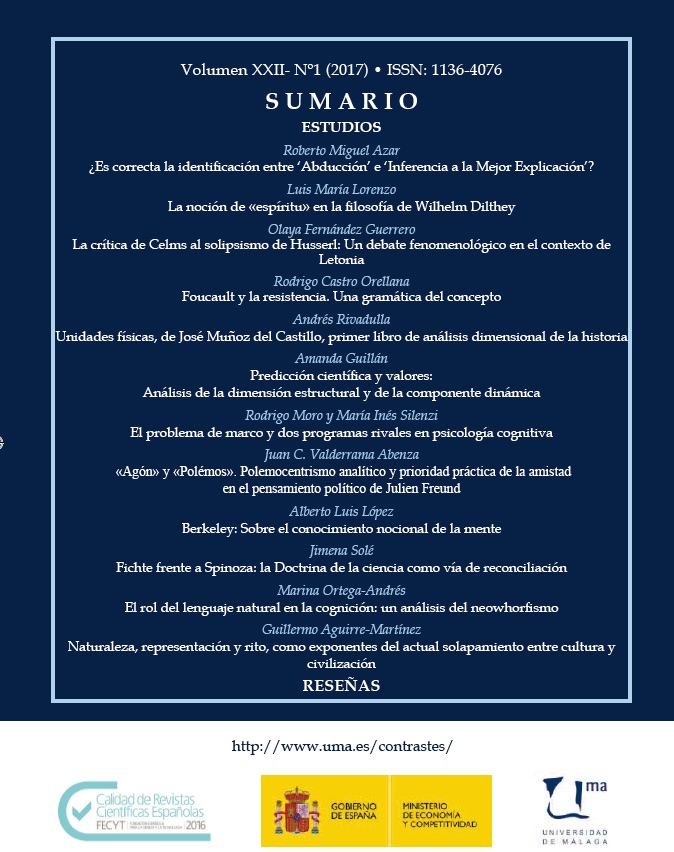Scientifi c Prediction and Values: An Analysis of the Structural Dimension and the Dynamic Trai
DOI:
https://doi.org/10.24310/Contrastescontrastes.v22i1.3417Keywords:
RESCHER, SCIENTIFIC PREDICTION, AXIOLOGY OF SCIENCE,, STRUCTURAL DIMENSION, DYNAMIC ASPECT.Abstract
When the problem of prediction is considered, two key issues should be considered its scientific value and the values that predictions embrace. This analysis of scientific prediction from an axiological perspective requires several steps. I) To take into account the general coordinates of the axiology of prediction, where the twofold character of the axiology of science is highlighted: the structural dimension and the dynamic aspect. II) To analyze a relevant approach to the values of prediction, such as Nicholas Rescher’s conception, which is mainly structural. III) To extend Rescher’s views on the relation between prediction and values, where a dynamic approach to the axiology of prediction is needed.
Downloads
Metrics
Publication Facts
Reviewer profiles N/A
Author statements
Indexed in
-
—
- Academic society
- N/A
- Publisher
- Universidad de Málaga
References
BEREIJO, A., 2011: «The category of ‘applied science’. An analysis of its justifi cation from ‘information science’ as design science», en González, W. J. (Ed.): Scientifi c realism and democratic society: The philosophy of Philip Kitcher, Poznan Studies in the Philosophy of the Sciences and Humanities, v. 101. Ámsterdam/N. York: Rodopi, pp. 329-353.
BRADY, E., 2014: «Aesthetic value, ethics and climate change», Environmental Values, v. 23, pp. 551–570.
FERNÁNDEZ VALBUENA, S., 1990: «Predicción y Economía», en González, W. J., (Ed.): Aspectos metodológicos de la investigación científi ca, 2ª ed. Madrid-Murcia: Ediciones Universidad Autónoma de Madrid y Publicaciones Universidad de Murcia, pp. 385-405.
GONZÁLEZ, W. J., 1998: «Prediction and Prescription in Economics: A Philosophical and Methodological Approach», Theoria, v. 13, (32), pp. 321-345.
___, 1999a: «Ciencia y valores éticos: De la posibilidad de la Ética de la Ciencia al problema de la valoración ética de la Ciencia Básica», en González, W. J. (Ed.): Ciencia y valores éticos, número monográfi co de Arbor, v. 162, (638), pp. 139-171.
___, 1999b: «Racionalidad científi ca y actividad humana. Ciencia y valores en la Filosofía de Nicholas Rescher», en Rescher, N.: Razón y valores en la Era científi co-tecnológica. Barcelona: Paidós, pp. 11-44.
___, 2010: La predicción científi ca.Concepciones fi losófi co-metodológicas desde H. Reichenbach a N. Rescher. Barcelona: Montesinos.
___, 2012: «Las Ciencias de Diseño en cuanto Ciencias de la Complejidad: Análisis de la Economía, Documentación y Comunicación», en González, W. J. (Ed.): Las Ciencias de la Complejidad: Vertiente dinámica de las Ciencias de Diseño y sobriedad de factores. A Coruña: Netbiblo, pp. 7-30.
___, 2013a: «Value ladenness and the value-free ideal in scientifi c research», en Lütge, Ch. (Ed.): Handbook of the philosophical foundations of business ethics. Dordrecht: Springer, pp. 1503-1521.
___, 2013b: «The roles of scientifi c creativity and technological innovation in the context of complexity of science», en González, W. J. (Ed.): Creativity, innovation, and complexity in science. A Coruña: Netbiblo, pp. 11-40.
___, 2013c: «The sciences of design as sciences of complexity: The dynamic trait», Andersen, H., Dieks, D., Gonzalez, W. J., Uebel, Th. y Wheeler, G. (eds.): New challenges to philosophy of science. Dordrecht: Springer, pp. 299-311.
___, 2015: Philosophico-Methodological Analysis of Prediction and its Role in Economics, Dordrecht: Springer.GUILLÁN, A., 2013: «Analysis of creativity in the sciences of design», en González, W. J. (Ed.): Creativity, innovation, and complexity in science. A Coruña: Netbiblo, pp. 125-139.
HARKER, D., 2008: «On the predilections for predictions», The British Journal for the Philosophy of Science, v. 59, pp. 429-453.
INTEMANN, K., 2015: «Distinguishing between legitimate and illegitimate values in climate modeling», European Journal of Philosophy of Science, v. 5, pp. 217-232.
NEIRA, P., 2015: «Values regarding results of the information and communication technologies: Internal values», en González, W. J. (Ed.): New perspectives on technology, values, and ethics: Theoretical and practical. Boston Studies in the Philosophy and History of Science. Dordrecht, Springer, pp. 47-60.
NIINILUOTO, I., 1993: «The aim and structure of applied research», Erkenntnis, v. 38, (1), pp. 1-21.
___, 2014: «Values in Design Sciences”, Studies in History and Philosophy of Science, v. 46, pp. 11-15.
PARKER, W., 2014: «Values and uncertainties in climate prediction, revisited», Studies in History and Philosophy of Science, v. 46, pp. 24-30.
RESCHER, N., 1993: A system of pragmatic idealism. Vol II: The validity of values. Princeton: Princeton University Press.
___, 1998a: Predicting the future. An introduction to the theory of forecasting. N. York: State University of N. York Press.
___, 1998b: «Communicative pragmatism», en Rescher, N.: Communicative pragmatism and other philosophical essays on language. Lanham, MD: Rowman and Littlefi eld, pp. 1-48.
___, 1999: Razón y valores en la Era científi co-tecnológica. Barcelona: Paidós.
___, 2012: «The problem of future knowledge», Mind and Society, v. 11, (2), pp. 149-163.
___, 2014: The pragmatic vision. Themes in philosophical pragmatism. Lanham, MD: Rowman and Littlefi eld.
SIMON, H. A., 1990: «Prediction and prescription in systems modeling», Operations Research, v. 38, pp. 7-14.
___, 1996: The sciences of the artifi cial,3ª ed. Cambridge, MA: The MIT Press (1ª ed., 1969; 2ª ed., 1981).
___, 2002: «Forecasting the future or shaping it? », Industrial and Corporate Change, v. 11, (3), pp. 601-605
Downloads
Published
How to Cite
Issue
Section
License
This journal provides immediate free access to its content under the principle of making research freely available to the public. All content published in Contrastes. Revista Internacional de Filosofía, are subject to the Creative Commons Attribution-NonCommercial-ShareAlike 4.0 license whose full text can be found at <http://creativecommons.org/licenses/by-nc-sa/4.0>
It is the responsibility of the authors to obtain the necessary permissions of the images that are subject to copyright.
Authors whose contributions are accepted for publication in this journal will retain the non-exclusive right to use their contributions for academic, research and educational purposes, including self-archiving or repository in open access repositories of any kind.
The electronic edition of this magazine is edited by the Editorial Service of the University of Malaga (Uma Editorial), being necessary to cite the origin in any partial or total reproduction.










5.png)
